Determining Offshore Ocean Significant Wave Height (SWH) Using Continuous Land-Recorded Seismic Data: An Example from the Northeast Atlantic
Abstract
:1. Introduction
2. Data Collection and Preparation
3. Methodology
4. Results
4.1. Trained and Tested Using Buoy SWH Data
4.2. Buoy Versus Numerical Model Hindcast SWH Data
4.3. Trained and Tested Using Numerical Wave Model Hindcast Data
4.4. Statistical Comparison of the ANN Predictions
5. Discussion and Conclusions
Author Contributions
Funding
Data Availability Statement
Acknowledgments
Conflicts of Interest
Abbreviations
| ANN | Artificial Neural Network |
| INSN | Irish National Seismic Network |
| MAE | Mean Absolute Error |
| MAPE | Mean Absolute Percentage Error |
| NEAO | Northeast Atlantic Ocean |
| PSD | Power Spectral Density |
| RMS | Root Mean Square |
| RMSE | Root Mean Square Error |
| RSMA | Square Root of SMA |
| sps | samples per second |
| SMA | Significant Microseism Amplitude |
| SWH | Significant Wave Heights |
References
- Bromirski, P.D. Vibrations from the “perfect storm”. Geochem. Geophys. Geosystems 2001, 2, 2000GC000119. [Google Scholar] [CrossRef]
- Tanimoto, T.; Anderson, A. Seismic noise between 0.003 Hz and 1.0 Hz and its classification. Prog. Earth Planet. Sci. 2023, 10, 56. [Google Scholar] [CrossRef]
- Li, X.; Xu, Y.; Xie, C.; Sun, S. Global characteristics of ambient seismic noise. J. Seismol. 2022, 26, 343–358. [Google Scholar] [CrossRef]
- Janssen, T.; Herbers, T.; Battjes, J. Evolution of ocean wave statistics in shallow water: Refraction and diffraction over seafloor topography. J. Geophys. Res. Ocean. 2008, 113, C03024. [Google Scholar] [CrossRef]
- Chevrot, S.; Sylvander, M.; Benahmed, S.; Ponsolles, C.; Lefèvre, J.; Paradis, D. Source locations of secondary microseisms in western Europe: Evidence for both coastal and pelagic sources. J. Geophys. Res. Solid Earth 2007, 112, B11301. [Google Scholar] [CrossRef]
- Ardhuin, F.; Gualtieri, L.; Stutzmann, E. How ocean waves rock the Earth: Two mechanisms explain microseisms with periods 3 to 300 s. Geophys. Res. Lett. 2015, 42, 765–772. [Google Scholar] [CrossRef]
- Farra, V.; Stutzmann, E.; Gualtieri, L.; Schimmel, M.; Ardhuin, F. Ray-theoretical modeling of secondary microseism P waves. Geophys. J. Int. 2016, 206, 1730–1739. [Google Scholar] [CrossRef]
- Stutzmann, E.; Ardhuin, F.; Schimmel, M.; Mangeney, A.; Patau, G. Modelling long-term seismic noise in various environments. Geophys. J. Int. 2012, 191, 707–722. [Google Scholar] [CrossRef]
- Kedar, S.; Longuet-Higgins, M.; Webb, F.; Graham, N.; Clayton, R.; Jones, C. The origin of deep ocean microseisms in the North Atlantic Ocean. Proc. R. Soc. A Math. Phys. Eng. Sci. 2008, 464, 777–793. [Google Scholar] [CrossRef]
- Hasselmann, K. A statistical analysis of the generation of microseisms. Rev. Geophys. 1963, 1, 177–210. [Google Scholar] [CrossRef]
- Ebeling, C.W. Inferring ocean storm characteristics from ambient seismic noise: A historical perspective. In Advances in Geophysics; Elsevier: Amsterdam, The Netherlands, 2012; Volume 53, pp. 1–33. [Google Scholar]
- Pellet, L.; Christodoulides, P.; Donne, S.; Bean, C.; Dias, F. Pressure induced by the interaction of water waves with nearly equal frequencies and nearly opposite directions. Theor. Appl. Mech. Lett. 2017, 7, 138–144. [Google Scholar] [CrossRef]
- Iafolla, L.; Fiorenza, E.; Chiappini, M.; Carmisciano, C.; Iafolla, V.A. Sea wave data reconstruction using micro-seismic measurements and machine learning methods. Front. Mar. Sci. 2022, 9, 798167. [Google Scholar] [CrossRef]
- Cutroneo, L.; Ferretti, G.; Barani, S.; Scafidi, D.; De Leo, F.; Besio, G.; Capello, M. Near real-time monitoring of significant sea wave height through microseism recordings: Analysis of an exceptional sea storm event. J. Mar. Sci. Eng. 2021, 9, 319. [Google Scholar] [CrossRef]
- Bensen, G.; Ritzwoller, M.; Barmin, M.; Levshin, A.L.; Lin, F.; Moschetti, M.; Shapiro, N.; Yang, Y. Processing seismic ambient noise data to obtain reliable broad-band surface wave dispersion measurements. Geophys. J. Int. 2007, 169, 1239–1260. [Google Scholar] [CrossRef]
- Nishida, K. Ambient seismic wave field. Proc. Jpn. Acad. Ser. B 2017, 93, 423–448. [Google Scholar] [CrossRef]
- Essen, H.H.; Krüger, F.; Dahm, T.; Grevemeyer, I. On the generation of secondary microseisms observed in northern and central Europe. J. Geophys. Res. Solid Earth 2003, 108, 2506. [Google Scholar] [CrossRef]
- Moni, A.; Craig, D.; Bean, C.J. Separation and location of microseism sources. Geophys. Res. Lett. 2013, 40, 3118–3122. [Google Scholar] [CrossRef]
- Aster, R.C.; McNamara, D.E.; Bromirski, P.D. Multidecadal climate-induced variability in microseisms. Seismol. Res. Lett. 2008, 79, 194–202. [Google Scholar] [CrossRef]
- Essen, H.H.; Klussmann, J.; Herber, R.; Grevemeyer, I. Does microseisms in Hamburg (Germany) reflect the wave climate in the North Atlantic? Dtsch. Hydrogr. Z. 1999, 51, 33–45. [Google Scholar] [CrossRef]
- Ardhuin, F.; Stutzmann, E.; Schimmel, M.; Mangeney, A. Ocean wave sources of seismic noise. J. Geophys. Res. Ocean. 2011, 116, C09004. [Google Scholar] [CrossRef]
- Beucler, É.; Mocquet, A.; Schimmel, M.; Chevrot, S.; Quillard, O.; Vergne, J.; Sylvander, M. Observation of deep water microseisms in the North Atlantic Ocean using tide modulations. Geophys. Res. Lett. 2015, 42, 316–322. [Google Scholar] [CrossRef]
- Bromirski, P.D.; Flick, R.E.; Graham, N. Ocean wave height determined from inland seismometer data: Implications for investigating wave climate changes in the NE Pacific. J. Geophys. Res. Ocean. 1999, 104, 20753–20766. [Google Scholar] [CrossRef]
- Le Pape, F.; Craig, D.; Bean, C.J. How deep ocean-land coupling controls the generation of secondary microseism Love waves. Nat. Commun. 2021, 12, 2332. [Google Scholar] [CrossRef] [PubMed]
- Le Pape, F.; Bean, C.J. North Atlantic Oscillation (NAO) climate index hidden in ocean generated secondary microseisms. Geophys. Res. Lett. 2021, 48, e2021GL093657. [Google Scholar] [CrossRef]
- Cannata, A.; Cannavò, F.; Moschella, S.; Di Grazia, G.; Nardone, G.; Orasi, A.; Picone, M.; Ferla, M.; Gresta, S. Unravelling the relationship between microseisms and spatial distribution of sea wave height by statistical and machine learning approaches. Remote Sens. 2020, 12, 761. [Google Scholar] [CrossRef]
- Donne, S.; Nicolau, M.; Bean, C.; O’Neill, M. Wave height quantification using land based seismic data with grammatical evolution. In Proceedings of the 2014 IEEE Congress on Evolutionary Computation (CEC), Beijing, China, 6–11 July 2014; pp. 2909–2916. [Google Scholar]
- Longuet-Higgins, M.S. A theory of the origin of microseisms. Philos. Trans. R. Soc. London. Ser. A Math. Phys. Sci. 1950, 243, 1–35. [Google Scholar]
- UK-MetOffice. Marine Observations—metoffice.gov.uk. Available online: https://www.metoffice.gov.uk/weather/specialist-forecasts/coast-and-sea/observations/ (accessed on 1 June 2024).
- Laboratoire d’Océanographie Physique et Spatiale (LOPS). LOPS Wave Data. 2024. Available online: https://www.umr-lops.fr/Donnees/Vagues (accessed on 1 June 2024).
- The MathWorks Inc. Optimization Toolbox Version: 9.4 (R2022b); The MathWorks Inc.: Natick, MA, USA, 2022; Available online: https://www.mathworks.com (accessed on 1 June 2024).
- Rajurkar, M.; Kothyari, U.; Chaube, U. Artificial neural networks for daily rainfall—Runoff modelling. Hydrol. Sci. J. 2002, 47, 865–877. [Google Scholar] [CrossRef]
- Dublin Institute for Advanced Studies. Irish National Seismic Network [Data Set]; International Federation of Digital Seismograph Networks: Parkfield, CA, USA, 1993. [Google Scholar] [CrossRef]
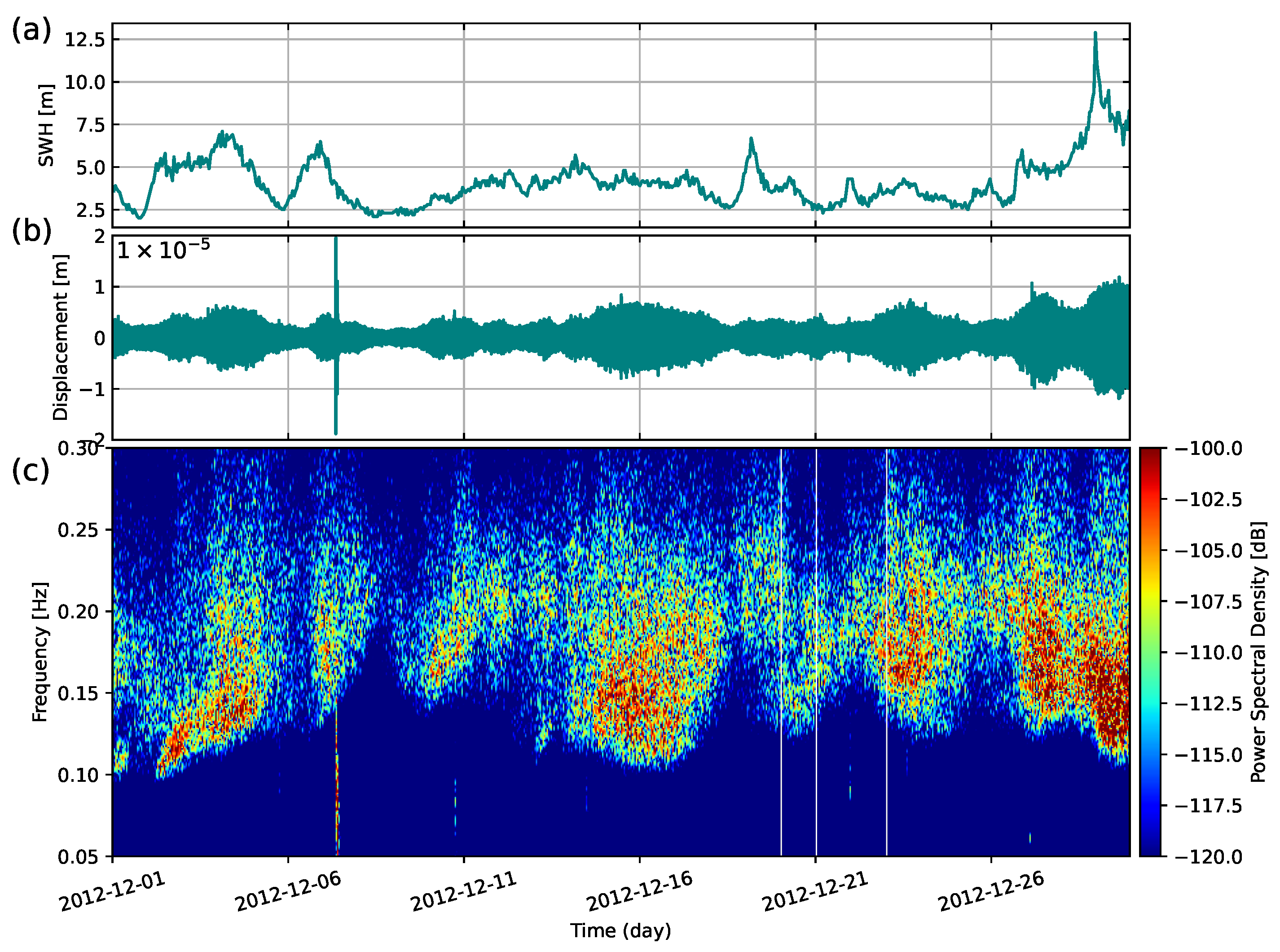
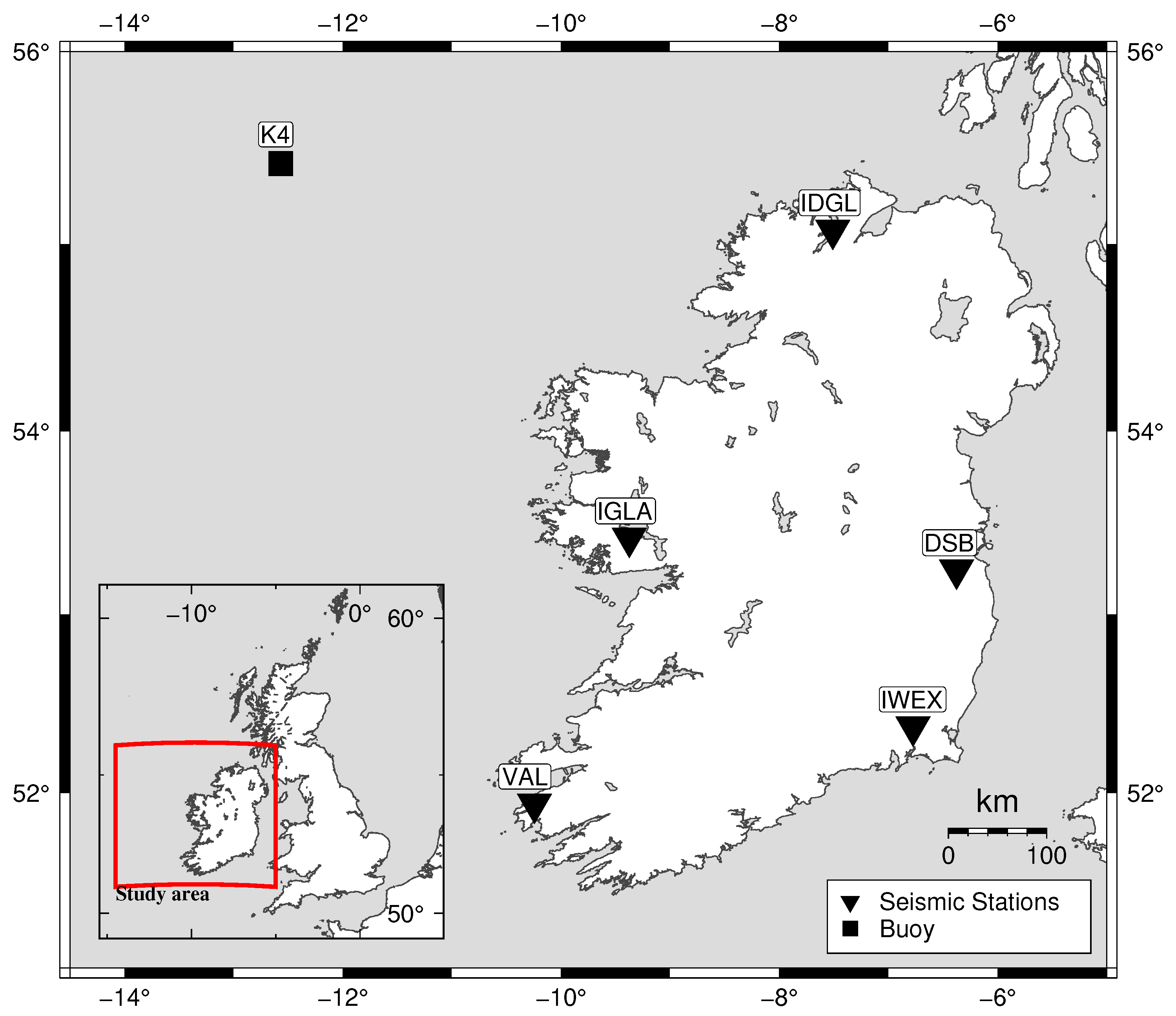
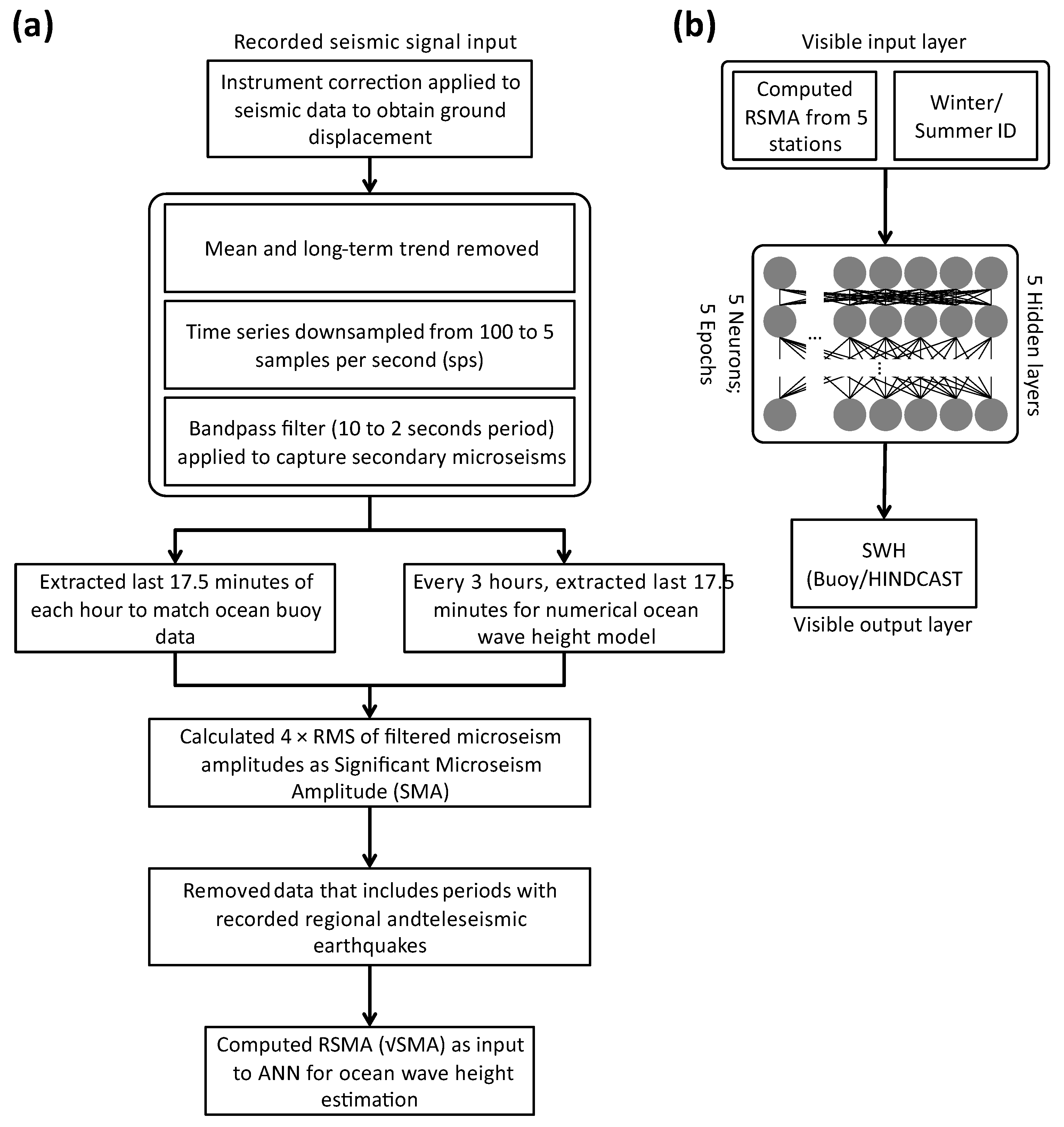

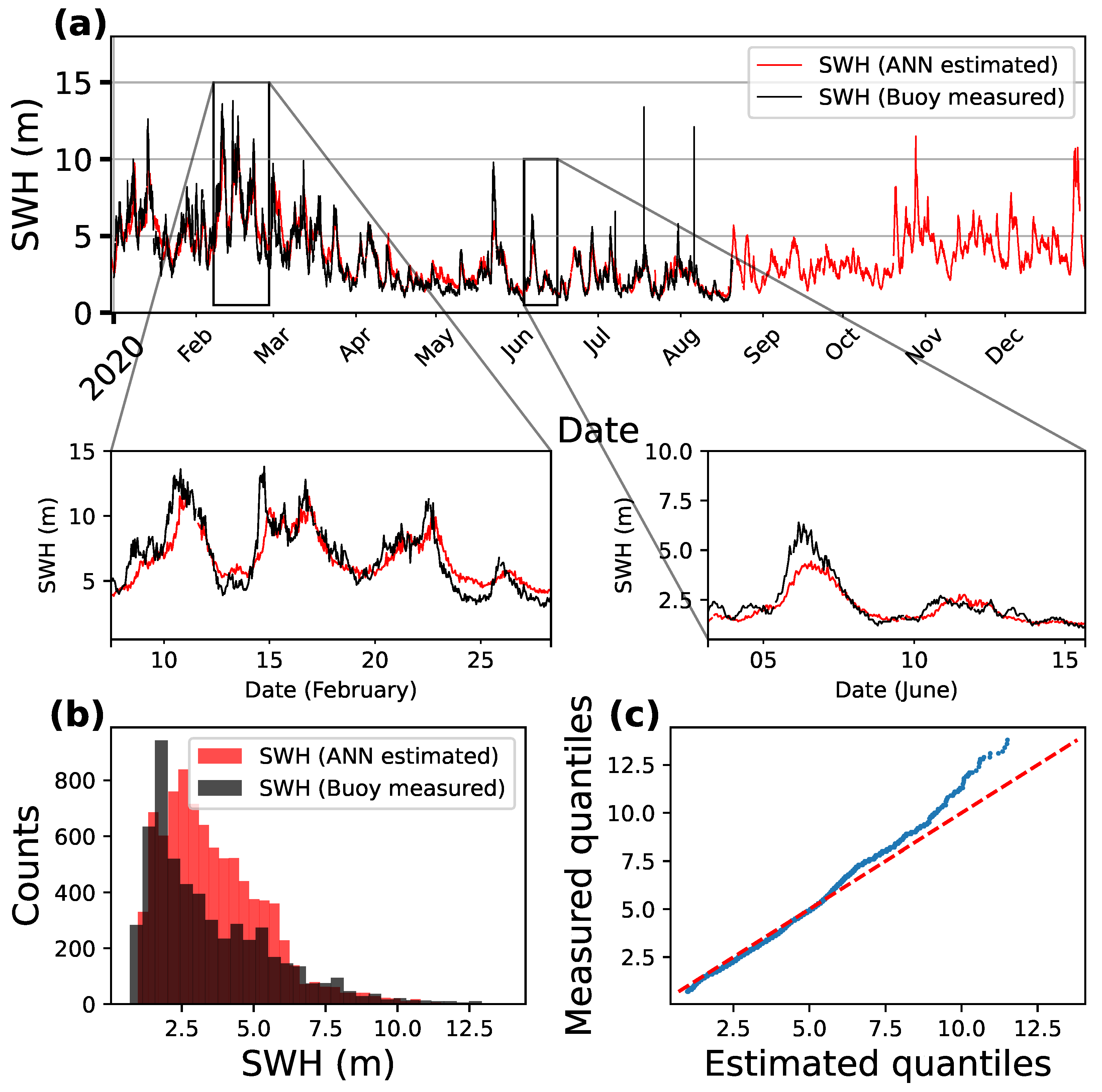
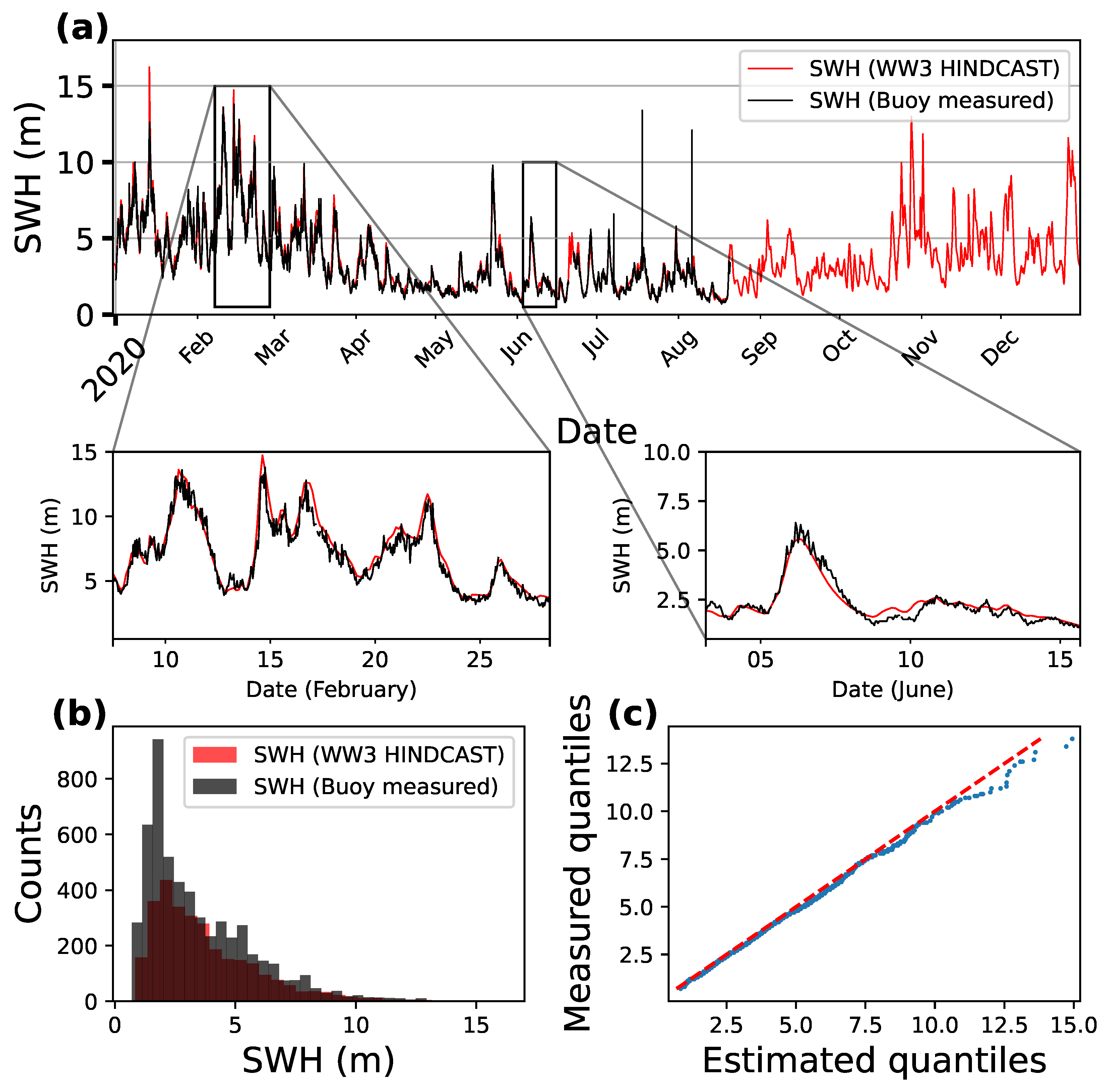
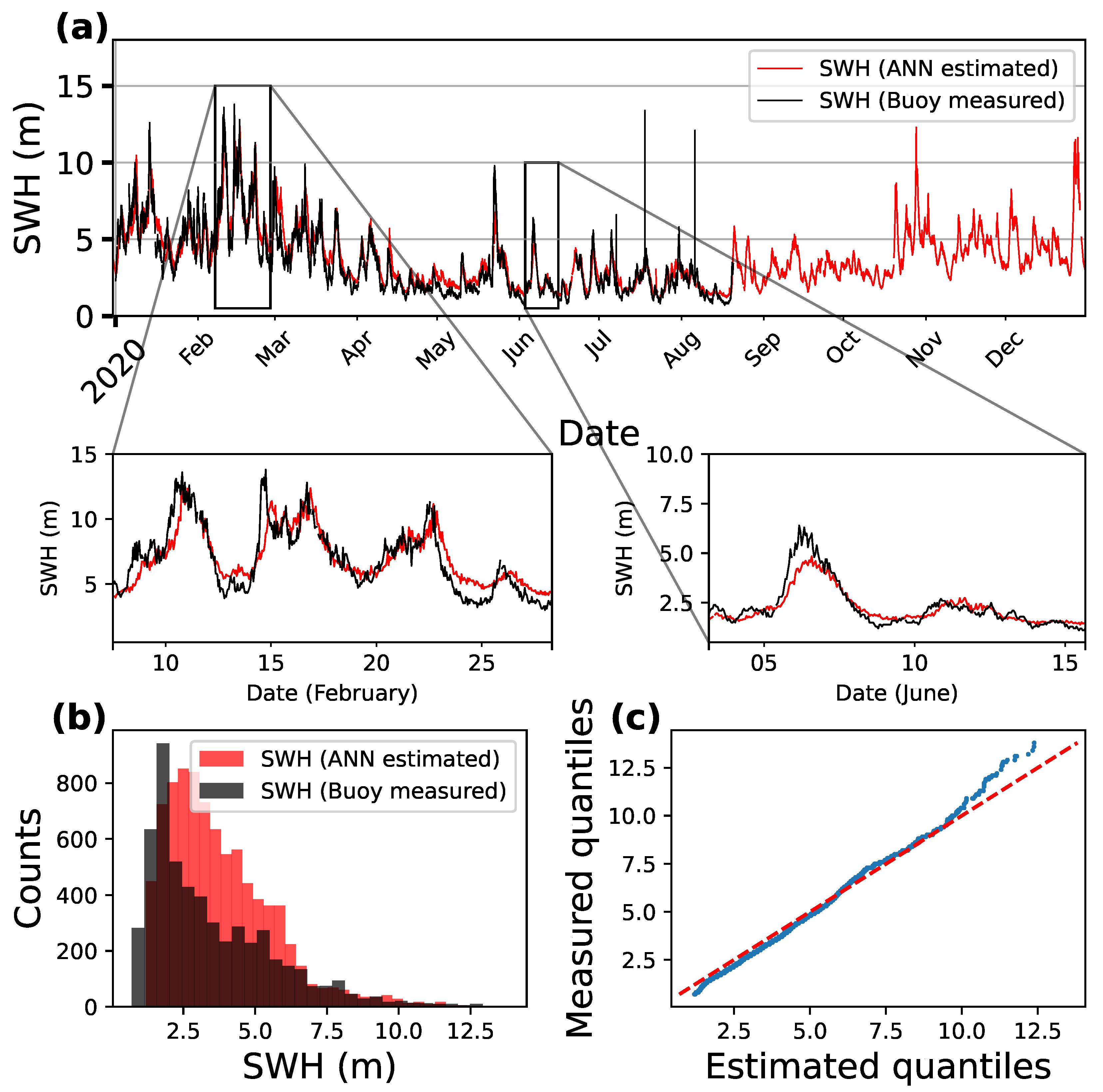
| ANN (Trained on Buoy Data) versus Buoy | Hindcast versus Buoy | ANN (Trained on Hindcast Data) versus Buoy | |
|---|---|---|---|
| RMSE | 0.8780 | 0.5356 | 0.9505 |
| MAE | 0.6132 | 0.3394 | 0.6816 |
| 0.8363 | 0.9426 | 0.8059 | |
| MAPE (%) | 19.6353 | 10.6708 | 20.2977 |
Disclaimer/Publisher’s Note: The statements, opinions and data contained in all publications are solely those of the individual author(s) and contributor(s) and not of MDPI and/or the editor(s). MDPI and/or the editor(s) disclaim responsibility for any injury to people or property resulting from any ideas, methods, instructions or products referred to in the content. |
© 2025 by the authors. Licensee MDPI, Basel, Switzerland. This article is an open access article distributed under the terms and conditions of the Creative Commons Attribution (CC BY) license (https://creativecommons.org/licenses/by/4.0/).
Share and Cite
Baranbooei, S.; Bean, C.J.; Rezaeifar, M.; Donne, S.E. Determining Offshore Ocean Significant Wave Height (SWH) Using Continuous Land-Recorded Seismic Data: An Example from the Northeast Atlantic. J. Mar. Sci. Eng. 2025, 13, 807. https://doi.org/10.3390/jmse13040807
Baranbooei S, Bean CJ, Rezaeifar M, Donne SE. Determining Offshore Ocean Significant Wave Height (SWH) Using Continuous Land-Recorded Seismic Data: An Example from the Northeast Atlantic. Journal of Marine Science and Engineering. 2025; 13(4):807. https://doi.org/10.3390/jmse13040807
Chicago/Turabian StyleBaranbooei, Samaneh, Christopher J. Bean, Meysam Rezaeifar, and Sarah E. Donne. 2025. "Determining Offshore Ocean Significant Wave Height (SWH) Using Continuous Land-Recorded Seismic Data: An Example from the Northeast Atlantic" Journal of Marine Science and Engineering 13, no. 4: 807. https://doi.org/10.3390/jmse13040807
APA StyleBaranbooei, S., Bean, C. J., Rezaeifar, M., & Donne, S. E. (2025). Determining Offshore Ocean Significant Wave Height (SWH) Using Continuous Land-Recorded Seismic Data: An Example from the Northeast Atlantic. Journal of Marine Science and Engineering, 13(4), 807. https://doi.org/10.3390/jmse13040807





